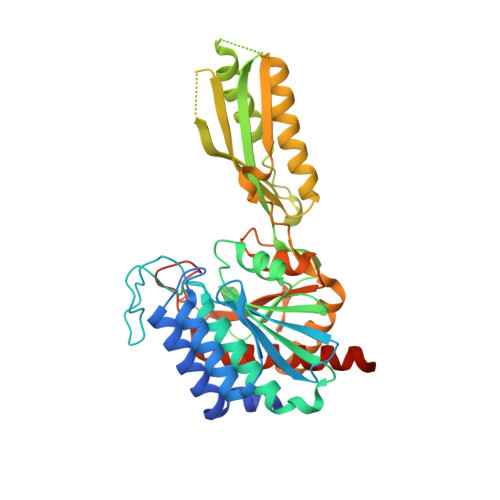X-ray structure of ILL2, an auxin-conjugate amidohydrolase from Arabidopsis thaliana.
Bitto, E., Bingman, C.A., Bittova, L., Houston, N.L., Boston, R.S., Fox, B.G., Phillips Jr., G.N.(2009) Proteins 74: 61-71
- PubMed: 18543330
- DOI: https://doi.org/10.1002/prot.22124
- Primary Citation of Related Structures:
1XMB - PubMed Abstract:
The plant hormone indole-3-acetic acid (IAA) is the most abundant natural auxin involved in many aspects of plant development and growth. The IAA levels in plants are modulated by a specific group of amidohydrolases from the peptidase M20D family that release the active hormone from its conjugated storage forms. Here, we describe the X-ray crystal structure of IAA-amino acid hydrolase IAA-leucine resistantlike gene 2 (ILL2) from Arabidopsis thaliana at 2.0 A resolution. ILL2 preferentially hydrolyses the auxin-amino acid conjugate N-(indol-3-acetyl)-alanine. The overall structure of ILL2 is reminiscent of dinuclear metallopeptidases from the M20 peptidase family. The structure consists of two domains, a larger catalytic domain with three-layer alpha beta alpha sandwich architecture and aminopeptidase topology and a smaller satellite domain with two-layer alphabeta-sandwich architecture and alpha-beta-plaits topology. The metal-coordinating residues in the active site of ILL2 include a conserved cysteine that clearly distinguishes this protein from previously structurally characterized members of the M20 peptidase family. Modeling of N-(indol-3-acetyl)-alanine into the active site of ILL2 suggests that Leu175 serves as a key determinant for the amino acid side-chain specificity of this enzyme. Furthermore, a hydrophobic pocket nearby the catalytic dimetal center likely recognizes the indolyl moiety of the substrate. Finally, the active site of ILL2 harbors an absolutely conserved glutamate (Glu172), which is well positioned to act as a general acid-base residue. Overall, the structure of ILL2 suggests that this enzyme likely uses a catalytic mechanism that follows the paradigm established for the other enzymes of the M20 peptidase family.
- Center for Eukaryotic Structural Genomics, University of Wisconsin-Madison, Madison, Wisconsin 53706-1544, USA.
Organizational Affiliation:
















